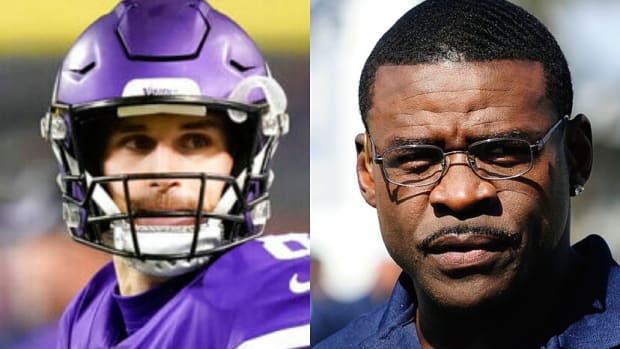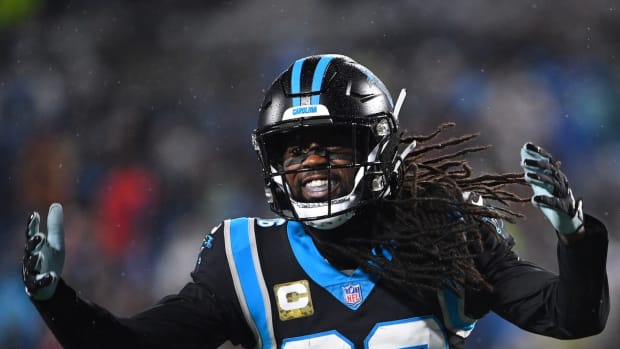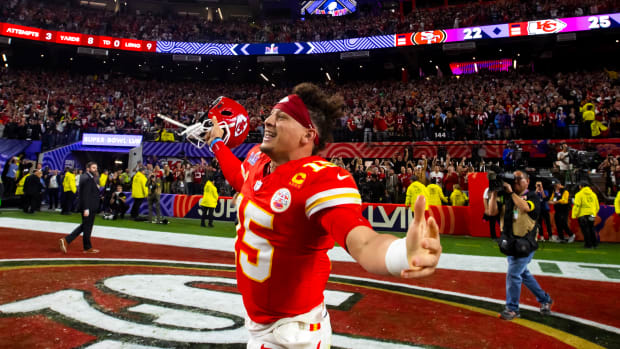Why Teams Should Be Nervous About Stidham and Patriots, the Steal of the Browns’ Draft, More Notes
Still more to clean up (and there will be for a while) from the 2019 NFL Draft …
1. There’s a very strong parallel between the Patriots taking LSU QB Danny Etling last year and Auburn QB Jarrett Stidham this year, and it’s not that they’re both from the SEC. Before the 2018 draft, New England saw Etling as a talented player who was in a system and with coaches that weren’t an ideal fit. Same goes for Stidham. Last summer, an NFC exec told me the two-year starter had the best arm talent in the class, and he’s widely seen as throwing the prettiest ball in the group. I’m not saying that he’s going to be Tom Brady’s successor, but other team should be at least a little nervous about this kid getting to work in the shadows with Bill Belichick and Josh McDaniels the next few years.
2. Looking for a draft steal? The Browns getting the tall, lanky Greedy Williams from the defensive back factory that is LSU at No. 46 absolutely has potential to be one. He was roundly seen as the most physically gifted corner in the class, but he has a bunch of growing up to do. Williams wasn’t always a willing tackler, and he came off in meetings with teams as having a pretty high opinion of himself. He also showed inconsistency against top-shelf competition (Alabama’s Jerry Jeudy, Georgia’s Riley Ridley). However Cleveland saw his competitiveness in coverage that they hope to translate into better tackling and more consistency as a pro. If the team can do that, this could be one heck of a bookend for Denzel Ward, well worth the fifth-rounder they spent to go up three picks to get him, and, from a value standpoint, may even make up for the first-rounder they lost in the Odell Beckham trade.
3. The Jets went safe with their first pick, taking one of the consensus top two (along with 49ers DE Nick Bosa) prospects in the draft. And then, absent a first-round pick, they rolled the dice with a some high-ceiling but character risks in Florida DE Jachai Polite and USC OT Chuma Edoga. The former is a first-round talent as a pass-rusher, but struggled in the months leading up to the draft, punctuated by a terrible string of combine interviews. The latter has been dogged by maturity questions, some concerning how he’ll handle life as a pro, and is very raw, but has the feet and athleticism to play left tackle in the NFL. This, of course, isn’t unusual when teams are missing high picks—the Jets’ second-rounder went to Indianapolis in the deal to get Sam Darnold. The clear idea is gamble a little to try and make up the difference.
4. Two years ago, the Jets made an effort to go up and get Alvin Kamara. This year, the team targeted another offensive weapon as they negotiated a trade with the Eagles (the New York Daily News’ Manish Mehta wrote on that today, and I confirmed it) at 57. And that effort was rendered moot by an aggressive play from the Chiefs to wrangle the 56th pick from the Rams, and get that player—Georgia’s Mecole Hardman. Obviously, the need there was pushed by Tyreek Hill’s situation, but the Chiefs aren’t under the illusion that Hardman will be what Hill has been. As they see it, he’s somewhere in-between Hill and De’Anthony Thomas as a h-back type of player, and I had another evaluator agree with that assessment.
Who were the Chiefs worried about? They knew about the Jets, but the Eagles and Colts, who also had receiver needs, were there, too. The Eagles, I’m told, actually liked Ohio State’s Parris Campbell more than Hardman for that kind of role, and wound up taking a more traditional receiver (Stanford’s J.J. Arcega-Whiteside) anymore. The Colts? They liked Hardman, but my understanding is they had Campbell, who they took at 59, ranked above him, too.
5. Speaking of the Colts, I’m told GM Chris Ballard wanted to emphasize speed and character in this year’s class. And while it’s hard to quantify the latter, we can the former. Defensive linemen Ben Banogu (second round) and Gerri Green (sixth round) were sixth and seventh, respectively, at their position group in the 40 at the combine. Third-roudner Bobby Okereke was 10th amoung linebackers, and fourth-rounder Khari Willis posted a strong time (4.52) for a safety. And Campbell’s 4.31 was first among receivers and third overall at the combine.
The one straggler was their first pick—second-round corner Rock Ya-Sin. He posted a middling (for a corner) 4.51. But Indy keeps their own combine times, rather than relying on the league’s times, and the slowest time they had on him was 4.48. Plus, they had him going from 4.32 in the short shuttle at combine to 4.18, and 7.34 in the three-cone at combine to 6.97 at his pro day, which bolstered the idea that he was better than he showed in their back yard. So all in all, the Colts accomplished what they were out to.
6. It’s a good sign that the Cowboys were drafting their needs a year out. Next year, Dallas RT La’el Collins will be up, and C Travis Frederick faces an uncertain future, so they got C/G Connor McGovern in the third round. And in 2020, DT Maliek Collins will be a free agent, so Dallas targeted, and landed UCF’s Trysten Hill to be his heir apparent. And they drafted a pair of defensive ends to give them flexibility down the line with Robert Quinn, Taco Charlton and Randy Gregory. The idea, of course, is to put yourself in a position to develop a guy for a year before you really need him, then collect a comp pick on the back end. It’s hard to actually pull this off, because you need to have a roster without too many pressing needs to do it, which is where the Cowboys are.
7. The Packers’ deal up from 21 to 30 for S Darnell Savage in the first round turned some heads, mainly because it was unclear who they were concerned about taking him. The Ravens (then at 22) just signed Earl Thomas, the Texans (at 23) were always taking a tackle, and the Raiders’ affection (at 24) for Josh Jacobs was no secret.
But here’s the thing: Savage was more highly thought of in league circles than most thought. Add that to the fact that defensive coordinator Mike Pettine is known for being particular about players—he has a smaller, more refined list in who he wants—and you can understand GM Brian Gutekunst’s aggression. So what’s Savage as a player? One veteran evaluator I talked to Monday saw him as a Rodney McLeod or Antoine Bethea type of player, a free safety with the ability to play nickel corner, too, which is pretty valuable in today’s NFL.
8. The Bills didn’t hide their affection for Houston DT Ed Oliver—they were front and center at his Pro Day—but that openness allowed the brass to get a lot of exposure to the kid. And they grew to love his swagger, his presence and his competitiveness. As you might imagine, they were thrilled he fell into their laps at 9.
9. Speed was important to the Ravens, but I feel like the idea that they were all hot-and-bothered to make their offense faster, because of the additions of Hollywood Brown and Justice Hill, has been a little overblown. Yes, they love Brown, but they also took Miles Boykin, who doesn’t quite play to his timed speed. And if they hadn’t taken Hill, they very much would’ve looked at the idea of taking David Montgomery, who went to the Bears in the third round, and isn’t exactly a burner. Add all that to the fact that Baltimore loved Jacobs (even though they wound up taking Brown at 22), and you can see Eric DeCosta wasn’t just trying to win a track meet with his first draft class as GM.
10. Finally, I wanted to double back to my talk with Dolphins GM Chris Grier from the other day. We were talking about the idea of pushing picks into 2020 (the Dolphins now have two picks in the second, fourth, sixth and seventh rounds next year), and here’s what he said: “I’d say a lot of credit has to go to our owner, Stephen Ross. When he decided to make a change, and that wasn’t easy, because Adam [Gase] and Mike [Tannenbaum] are good people, and they’re good at jobs, Steve, from his point of view, wanted a different approach to build a long-term winner. … Steve was really the one that said, ‘OK, how?’ And I laid it out, from my past experiences, I’ve been around a lot of good coaches, and a lot of good mentors in the personnel world, we just decided we were going to build this thing from the ground up. It’s not trying to build just to win right now. If that happens, great. We’re not trying to tank or lose. And I’d say the moves we’ve made so we’re going to be competitive, we’re going to be young, and we’re going to try and win games. But we’re going to build it the right way, and acquiring picks just happens to be an added bonus. … Obviously, the more picks you have allows you flexibility in any year. If there are players you really like in the current class, you can go get those players now. Or you build towards the future, and keep building the right way. If you acquire picks here and there, it allows you to do things in the future. It creates a lot of opportunity to stay very flexible in your approach in terms of what you want to do in the draft, free agency, everything.” I think it’s very, very smart, and a sign the Dolphins are in the right hands.
O.K., and a bonus 11th item. I did ask Grier if he and his staff started to look at the 2020 draft class of quarterbacks (the Jets and Browns did that with the 2018 class early in 2017, to compare one group to the other). “When you’re out evaluating, you’re always looking at every position, and you try and look ahead maybe into the future, but the draft is so important, of that year, every year, that you never want to take anything for granted,” Grier said. “Like, ‘We’re definitely gonna be able to do this or that.’ No, we spent a lot of time on all the players this year, we spent a lot of time with the quarterbacks this year. Every scouting department is doing that as well. You’re always looking to see this year’s. And when you’re in a school, you always notice good players. They’re in your mind. But you don’t really study them because you don’t know them. That’s the advantage the current draft class always has, because you get to know the person, the kid he is, the intelligence, the character. With future classes, we don’t know that stuff, and that always plays a big part of any position, whether it’s a quarterback or not.” But the work towards that class, even with Josh Rosen on the roster, will start, pretty much, right now.
Twelve months to go!
Question or comment? Email us at talkback@themmqb.com.




































